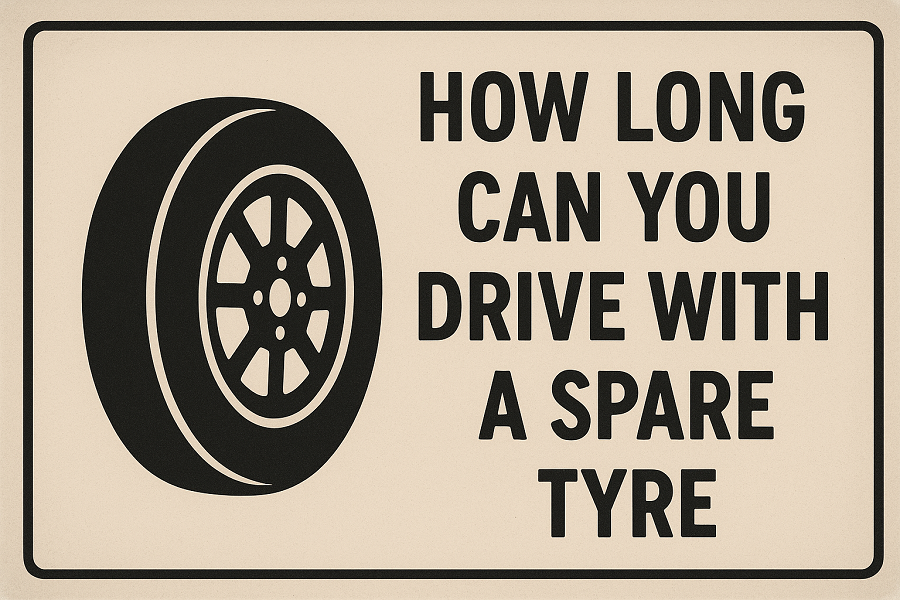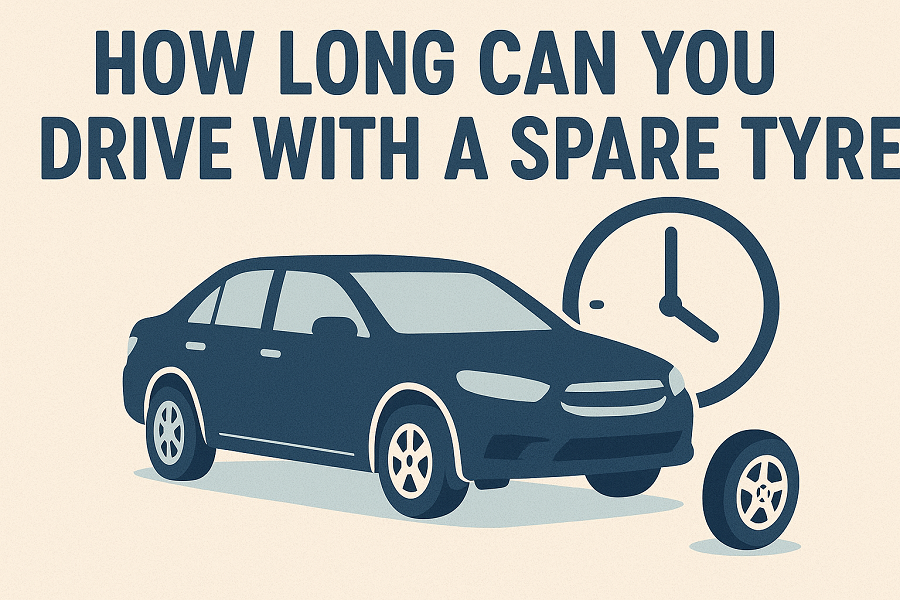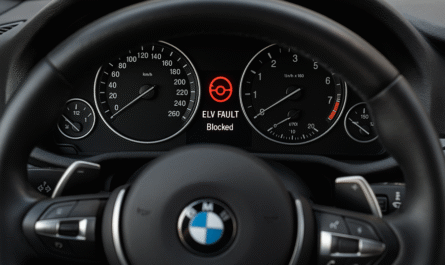Table of Contents
Table of Contents
Imagine this: you’re cruising down the road, enjoying your favorite playlist, when unexpectedly thump, thump, thump a flat tyre. Your heart sinks, but thankfully, you’ve got a spare tyre in the boot. You swap it out, but now you’re wondering, how long can you drive with a spare tyre? It’s a question that pops up for numerous drivers, and the solution isn’t as easy as you might think. Spare tyres are a lifesaver, but they’re not meant for the long haul. In this guide, we’ll break down everything you need to know about driving on a spare tyre, from types and limitations to safety tips and legal considerations.
Whether you’re dealing with a compact “donut” spare or a full-size spare, understanding how to use it safely can prevent further damage to your car and keep you safe on the road. Let’s dive in!
What Is a Spare Tyre?
A spare tyre is a backup wheel stored in your car for emergencies like a flat or busted tyre. It’s designed to get you to a repair shop or a safe location, not to replace your regular tyre permanently. Most vehicles come with one of two types of spare tyres: a full-size spare or a compact (donut) spare. Each has its purpose, benefits, and limitations.
Full-Size Spare Tyres
A full-size spare is similar to the tyres already on your car. It matches in size, tread, and load capacity, meaning it can control the exact driving conditions as your normal tyres. Some full-size spares are “matching” (exact replicas of your current tyres), while others are “non-matching” (similar but not identical). These spares are ordinary in bigger vehicles like SUVs or trucks, where space and weight aren’t as big of a concern.
The upside? You can drive on a full-size spare for longer distances and at normal speeds, but it’s still not a permanent fix. If it’s a non-matching spare, differences in tread or wear can affect your car’s handling.
Compact (Donut) Spare Tyres
The compact spare, often called a “donut,” is smaller, more lightweight, and narrower than a normal tyre. It’s invented to save space and weight in your car, making it easier to keep in the boot. However, donut spares are strictly temporary. They have less tread, a lower load capacity, and are built for short distances at reduced speeds.
Donut spares are common in smaller cars, where boot space is limited. While they’re convenient, they come with strict limitations, which we’ll explore next.
How Long Can You Drive on a Spare Tyre?
The question of how long you can drive with a spare tyre depends on the type of spare, your driving conditions, and manufacturer guidelines. Let’s break it down.
Distance and Speed Limitations for Donut Spares
Donut spares are not created for extended use. Most factories recommend driving no more than 50 to 70 miles (80 to 113 kilometers) on a donut spare. This distance is enough to bring you to a repair shop or a secure location, but not greatly further. Exceeding this limit can wear out the tyre quickly, raising the risk of a blowout or harm to your vehicle.
Speed is another crucial factor. Donut spares generally have a maximum speed limit of 50 mph (80 km/h). Driving faster can cause the tyre to overheat, lose traction, or fail. Always check the sidewall of your spare tyre for specific speed and distance recommendations, as these can vary slightly by brand.
Full-Size Spare Distance and Speed
Full-size spares are more durable than donuts, but they’re still not meant for long-term use. If you have a matching full-size spare, you can drive for several hundred miles in some cases. It’s delivered in good condition and correctly inflated. However, non-matching full-size spares may have various tread patterns or wear levels, which can impact your car’s alignment, handling, or braking.
Even with a full-size spare, stick to normal driving speeds unless otherwise specified by the factory. Avoid forceful driving, such as sharp turns or sudden stops, to maintain safety.
Manufacturer Recommendations
Every spare tyre comes with manufacturer guidelines published on the sidewall or in your car’s owner’s manual. These guidelines specify the highest speed, distance, and load capacity for the tyre. For example, Bridgestone and Michelin often set a 50-mile limit for their donut spares, while full-size spares may not have a tough mileage cap but should still be replaced promptly.
Neglecting these suggestions can cancel warranties or lead to unsafe driving conditions. Always follow the manufacturer’s advice to bypass expensive repairs or accidents.

Legal Considerations for Driving on a Spare Tyre
Driving laws vary by country, and some regions have specific rules about spare tyre use. Here’s a quick look at legal considerations in a few key areas:
United States
In the US, there are no federal laws banning driving on an extra tyre for comprehensive periods, but state laws may differ. For example, some states demand all tyres to meet lowest tread depth standards, which could apply to spares. Driving on a worn-out or impaired spare could result in a fine or citation during a vehicle inspection.
United Kingdom
In the UK, the Road Vehicles (Construction and Use) Regulations demand all tyres to be eligible for the car and road conditions. A donut spare may not fulfill these standards for long use, especially on motorways. If you’re detected driving unsafely on a spare tyre, you could face fines or penalty points on your license.
Other Countries
In countries like Australia and Canada, equivalent rules apply. Spare tires must be roadworthy, and long use could violate auto safety standards. Check local regulations before moving long distances on a spare.
To stay on the correct side of the law, replace your spare tyre with a good one as soon as possible.
Risks of Prolonged Use of a Spare Tyre
Driving on a spare tyre beyond its intended purpose can lead to serious issues. Here’s why you should avoid using a spare for too long:
Handling and Stability
Spare tyres, especially donuts, have less grip and a separate profile than normal tyres. This can cause your car to handle poorly, mainly in watery or slippery conditions. Uneven tyre sizes (e.g., a donut spare on one wheel and regular tyres on the others) can also throw off your vehicle’s balance, affecting steering and suspension.
Braking Issues
A spare tyre’s smaller size or different tread pattern can reduce braking efficiency. This is especially dangerous at high speeds or in emergencies, where quick stops are critical.
Vehicle Damage
Long use of a spare tyre can weaken your car’s suspension, alignment, or differential, particularly if the spare doesn’t match your other tyres. This can lead to expensive repairs, such as replacing worn-out components or realigning your wheels.
Safety Risks
The greatest concern is protection. A worn-out or overused spare tyre is more likely to blow out, putting you, your passengers, and other drivers at risk. Don’t take chances get your normal tyre repaired or replaced promptly.
Tips for Driving on a Spare Tyre
Once you’ve installed a spare tyre, follow these steps to stay safe and protect your vehicle:
Check Tyre Pressure
Spare tyres can lose air over time, especially if they’ve been sitting in your trunk for years. Check the pressure before driving and inflate it to the manufacturer’s recommended PSI (usually printed on the tyre or in your owner’s manual). A tyre pressure gauge is a handy tool to keep in your car.
Drive Cautiously
Stick to the speed limit (or lower, for donut spares) and avoid sudden maneuvers. Take smooth turns, brake gently, and avoid rough roads or potholes that could damage the spare.
Find a Repair Shop ASAP
Your spare tyre is a temporary fix, not a long-term solution. Locate a nearby repair shop or tyre center as soon as possible. If you’re on a road trip, use GPS or a map app to find the closest service station.
Inspect the Spare Regularly
If you must drive on the spare for more than a day, check its condition daily. Look for signs of wear, cracks, or low pressure. If anything seems off, stop driving and seek professional help.
Replace the Damaged Tyre
Once you reach a repair shop, have your damaged tyre repaired or replaced. If the tyre is beyond repair, consider replacing it with one that matches your other tyres to ensure consistent performance.
Conclusion: Drive Smart, Stay Safe
A spare tyre is a lifesaver in a pinch, but it’s not meant to replace your normal tyre for long. Donut spares should be driven no more than 50–70 miles at speeds under 50 mph, while full-size spares offer more flexibility but still require prompt replacement. Ignoring manufacturer guidelines or local laws can lead to safety risks, vehicle damage, or legal trouble. By driving cautiously, checking your spare’s condition, and heading to a repair shop quickly, you can stay safe and get back on the road with confidence.



